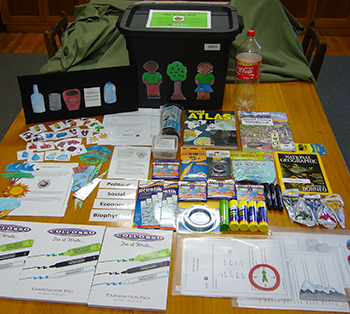
The Green Box |
The Department of Geography at the University of the Free State (UFS), in association with the Society of South African Geographers (SSAG), is doing their part in providing curriculum support to schools. Dr Ruth Massey and Anneri Pretorius are the project managers of Green Box, an initiative to advance Geography in schools.
The Green Box supports the intermediate phase of schooling (Grades 4, 5, 6). According to Dr Massey, the worksheets and activities provided in the Green Box are aligned with the Curriculum and Assessment Policy Statements (CAPS) and the new curriculum. “These worksheets are divided into three themes: map work, physical Geography, and human Geography.
“Map work includes symbols and keys, grid references, and compass work whilst physical Geography focuses on water and waste, biodiversity and conservation, and weather and climate issues. The human Geography theme has a focus on population, rural and urban development, migration, food and farming, and transport and trade,” she said.
Each worksheet has a fact sheet section which teaches theory on the specific topic (linked to the curriculum), an activity section (all resources needed for these activities are provided in the box), and a ‘take it home’ section for further learning and practice at home.
The Green Box is a recycled plastic crate that comprises worksheets, training materials, visual aids, and resources for teaching, learning, and active engagement in Geography classes.
Also included in the box are a felt story board and characters (that link with the worksheet activities), the ‘Climate Change memory game’ (which enhances learner’s memory capabilities and teaches various climate change facts) and the ‘Sustainable Development puzzle game’ (which teaches about the social, biophysical, economic, and political elements of Sustainable Development, and how they overlap).
“All items in the box are locally sourced, robust, and without copyright,” said Dr Massey.
The project is focusing on 10 under-resourced schools in the Bloemfontein area. Each school has received three boxes (one for each grade of the Intermediate Phase).
Dr Massey said: “This box is to be shared among the teachers. The Green Boxes were distributed at a training and information workshop held at three central schools in the various districts. These workshops introduced the teachers to the contents of their box, and provided basic training on the worksheets and the activities provided.”
“The schools will be joined up with ‘Box Buddies’ at more resourced schools in Bloemfontein. These buddy schools will assist in support and in replenishing the box’s stationery, etc. when needed.”
“Monitoring and evaluation will take place for six months after the boxes have been distributed. This will ensure support to, and the sustainability of, the project.” The Green Box project was made possible through a grant from the Society of South African Geographers (SSAG).